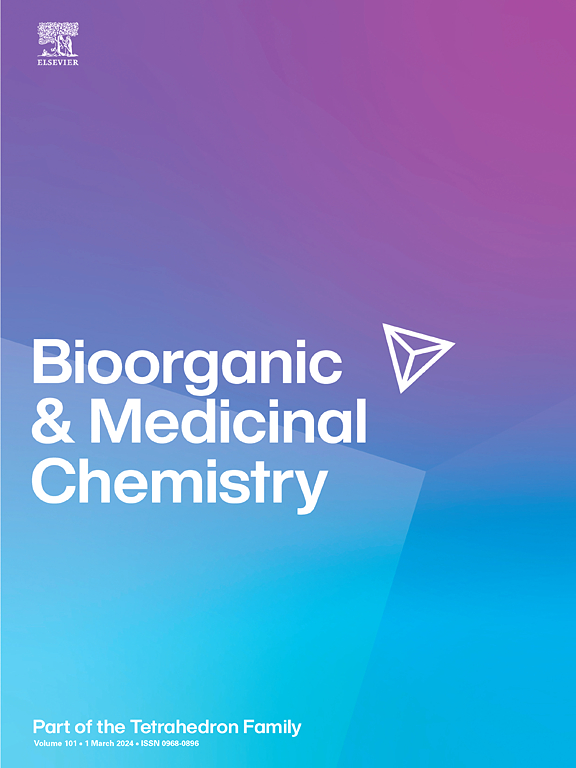磺胺多辛通过多组分反应衍生得到新的抗疟原虫化合物
IF 3
3区 医学
Q2 BIOCHEMISTRY & MOLECULAR BIOLOGY
引用次数: 0
摘要
疟疾继续对疾病流行的国家造成破坏性影响。尽管取得了重大进展,但能够避免耐药性的新药的发现和开发仍然是一个挑战。同样,药物发现过程的难度和复杂性只会加剧这种情况。如今,出现了一些新的策略,以尽量减少耐药性进化所带来的影响,例如通过化学适应来改善已有的药物。在这项工作中,我们描述了抗疟疾药物磺胺多辛的结构修饰,寄生虫对其产生了耐药性。由于磺胺多辛在其结构中显示出能够进行Povarov和Ugi多组分反应的苯胺残基,我们利用这些来获得新的衍生物。具体来说,在Povarov反应中,当苯乙烯作为亲二亲和剂时,磺胺多辛会生成苯基喹啉-6-磺酰胺衍生物5,或者当茚代替苯乙烯时,磺胺多辛会生成茚[2,1-c]喹啉-2-磺酰胺衍生物8a, 9和10。而以磺胺多辛为残留胺进行Ugi反应,得到衍生物13a和13b。合成的衍生物8a、13a和13b的体外抗疟原虫活性明显高于原始的磺胺多辛化合物,这些类似物与乙胺嘧啶联合的协同实验显示,与磺胺多辛-乙胺嘧啶相比,这些类似物的体外抗疟原虫活性明显提高。本文章由计算机程序翻译,如有差异,请以英文原文为准。

Sulfadoxine derivatization through multicomponent reactions to obtain new antiplasmodial compounds
Malaria continues to have a devastating impact on disease-endemic countries. Despite significant advances have been achieved, the discovery and development of new drugs capable to avoid resistances remains a challenge. In the same way, the difficulty and complexity of drug discovery processes only aggravates this situation. Nowadays, new strategies have appeared to minimize the impact that resistance evolution entails, such as the improvement of pre-existing drugs through chemical adaptation. In this work, we describe the structural modification of the antimalarial drug sulfadoxine, to which the parasite has developed resistance. Since sulfadoxine displays in its structure an aniline residue capable of undergoing Povarov and Ugi multicomponent reactions, we have used these to obtain new derivatives. Specifically, in the Povarov reaction, sulfadoxine led to phenylquinoline-6-sulfonamide derivatives 5 when phenylstyrene was used as dienophile, or indeno[2,1-c]quinoline-2-sulfonamide derivatives 8a, 9 and 10 when indene was used instead. On the contrary, when sulfadoxine was used as the residue amine in the Ugi reaction, derivatives 13a and 13b were obtained. Some of the synthesized derivatives, namely 8a, 13a and 13b displayed a significantly higher in vitro antiplasmodial activity than the original sulfadoxine compound, and synergistic assays of these analogues in combination with pyrimethamine showed improved efficacy compared to sulfadoxine-pyrimethamine.
求助全文
通过发布文献求助,成功后即可免费获取论文全文。
去求助
来源期刊

Bioorganic & Medicinal Chemistry
医学-生化与分子生物学
CiteScore
6.80
自引率
2.90%
发文量
413
审稿时长
17 days
期刊介绍:
Bioorganic & Medicinal Chemistry provides an international forum for the publication of full original research papers and critical reviews on molecular interactions in key biological targets such as receptors, channels, enzymes, nucleotides, lipids and saccharides.
The aim of the journal is to promote a better understanding at the molecular level of life processes, and living organisms, as well as the interaction of these with chemical agents. A special feature will be that colour illustrations will be reproduced at no charge to the author, provided that the Editor agrees that colour is essential to the information content of the illustration in question.
 求助内容:
求助内容: 应助结果提醒方式:
应助结果提醒方式:


